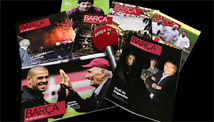FCBARCELONA.CAT
Main menu

Content menu
Club
10.06.2010 11:30
Barça and presidential elections (I)
Manel Tomàs
The ways of becoming Barça president have changed over the years. We have come to take democratic elections for granted, but they have only been the standard practice since 1978.
When Joan Gamper and eleven friends founded FC Barcelona on November 29, 1899 the first thing they did was name the first president of the club. Gamper refused the honour and proposed his trusted colleague, Englishman Walter Wild. He was accepted unanimously.
Members assembly selects president until 1936
A rotation system was set up, with short presidential mandates of a maximum of two years, and powers were passed on between friends and by general consensus. The members assembly voted for their leaders but the matter was rarely high on the agenda and rarely caused much discussion.
Arcadi Balaguer, chosen in 1925, was the first president to be imposed by the authorities following the closure of Les Corts ground in June. Presidential elections thereafter were up against the difficult circumstances of the period, but always enjoyed majority support from the members, who automatically accepted their presidents at general assemblies.
Committee of Employees in the war
Following the outbreak of Civil War, the death of president Josep Sunyol meant that on August 15, 1936 a Committee of Employees was named to oversee Barça’s future. On November 29, 1937 Francesc X. Casals became the new president of the club, and Sunyol was posthumously named president “in absence”. Casals was not chosen by general assembly but at a board meeting. Due to the war, there would be no further elections until 1935.
Presidents appointed from Madrid
At the end of the war, a Managing Commission governed the club until March 13, 1940 when the National Delegation for Sports nominated Enrique Piñeyro as the new president of Barça. Under the Franco dictatorship, the Spanish sports authorities were responsible for naming FCB presidents. Not only were the members denied the right to vote, but they could not even form assemblies.
The rules were later relaxed, and on September 20, 1946 the club’s own directors were able to name a new president in Agustí Montal Galobart who called an assembly in July 1948, although the regime only allowed 1% of the total number of members to attend. He was ratified in his position and in 1952 he handed his role on to Enric Martí Carreto. He was only president for a year, because on September 22, 1953 he resigned in the wake of the unfair resolution of the “Di Stéfano case”
Pseudo-democratic elections
In compensation for the loss of Di Stéfano, the Franco regime allowed Barça members to vote democratically for their presidents once more. On November 14, 1953 all adults that had been members for at least two years (except women, who were excluded) named their new president Francesc Miró-Sans. That election was adulterated, for it was never checked whether the voters were actually the members in person, and the whole affair was blighted by the scandal. In fact, some people were even allowed to vote with more than one membership card.
Elections by representatives
The November 1953 experience was not repeated and until the end of the dictatorship, the system for
electing Barça presidents was by drawing representatives to vote, along with particularly
noteworthy members and former presidents. This restricted formula enabled Miró-Sans to retain his
position in 1958 and in 1961 Enric Llaudet came into power, and regained his position four years
later.
Curiously, in 1968 Narcís de Carreras was named president like in the old days, by general accord. After that, Agustí Montal Costa (son of Montal Galobart) became the last president to be chosen using the representative system, which he won in 1969 and 1973.
Curiously, in 1968 Narcís de Carreras was named president like in the old days, by general accord. After that, Agustí Montal Costa (son of Montal Galobart) became the last president to be chosen using the representative system, which he won in 1969 and 1973.

